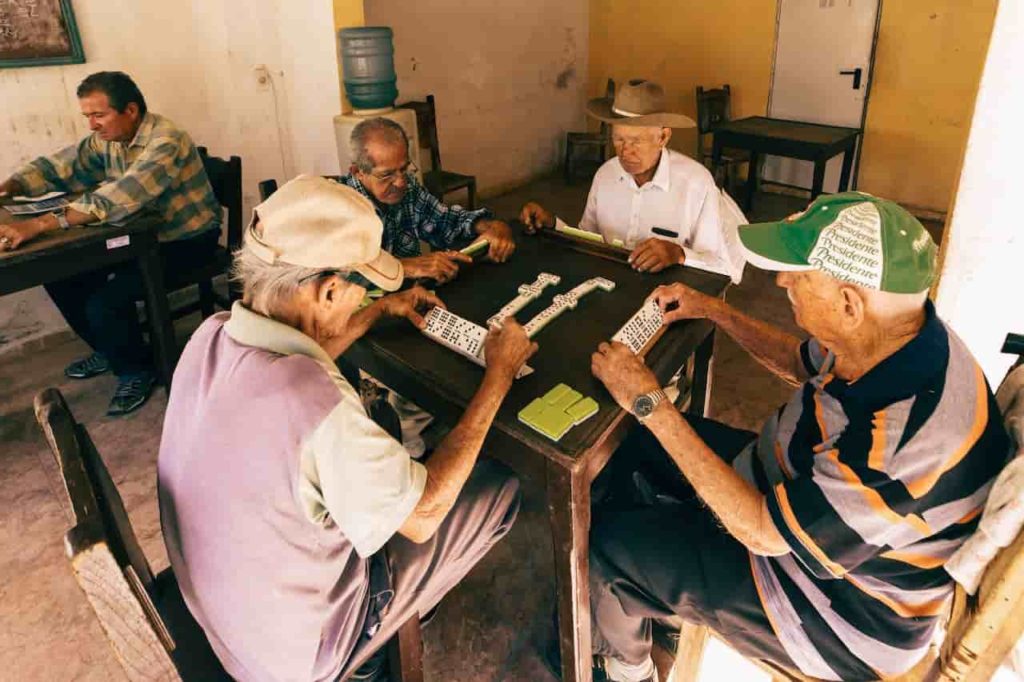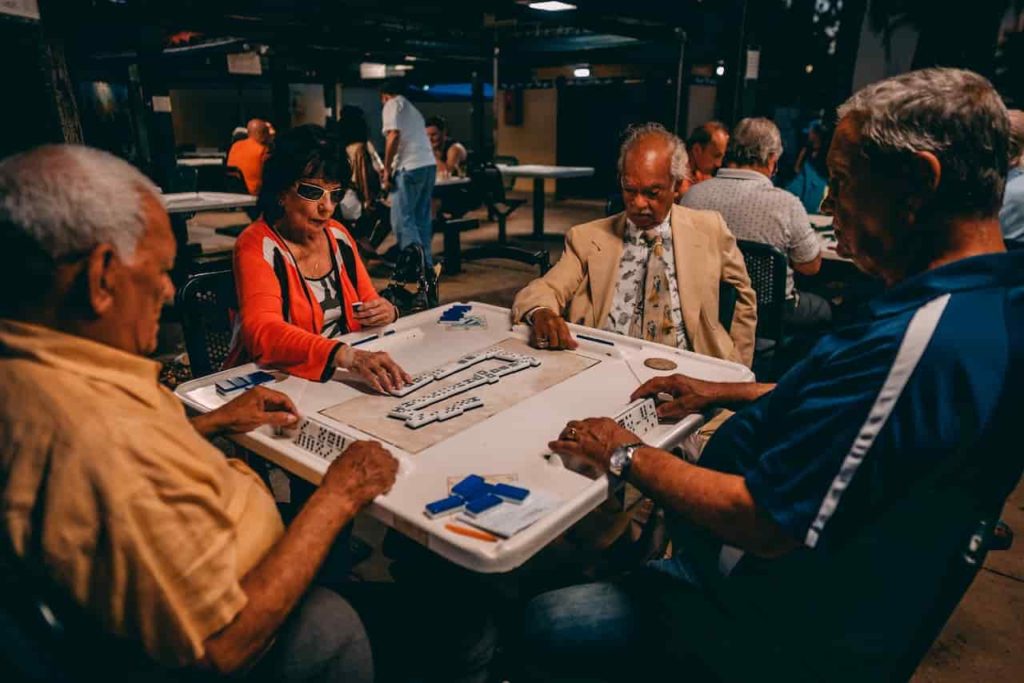What is Mahjong?
Mahjong is derived from two Chinese words: “ma” meaning sparrow and “jiang” meaning general. The name reflects the origins of the game when it was played using paper cards decorated with pictures of birds and animals.
Today, mahjong is usually played using small tiles made from bone or bamboo wood. The tiles are divided into three main categories: suits, honors, and flowers.
There are three suits in mahjong: bamboo (or sticks), characters (or numbers), and dots (or circles). Each suit consists of nine tiles numbered one through nine.
Honors consist of eight tiles that represent winds (east, west, north, south) and dragons (red, green, white). There are four flower tiles which do not belong to any suit but can be used to replace missing tiles.
The Origin Story of Mahjong
There are several legends surrounding the origin of mahjong. One story suggests that Confucius created the game around 500 BC as a way to teach strategy to his students. Another story claims that a nobleman during the Ming dynasty invented mahjong as a way to pass time while waiting for his troops to return from battle.
Regardless of its true origin story, historians agree that mahjong evolved from similar Chinese card games dating back over 1,000 years. The game’s popularity grew during the 19th century when it became a popular pastime among the wealthy and was soon adopted by the masses.
The Cultural Significance of Mahjong
Mahjong has played an important role in Chinese culture for centuries. The game is often played during festivals and other celebrations, bringing families and friends together.
It is also considered a symbol of luck and fortune, with many players believing that winning a game will bring good fortune in their lives. Mahjong has also been featured prominently in literature, art, and film throughout history.
It has been used as a metaphor for life’s challenges and as a representation of Chinese culture to the world. Today, mahjong continues to be an important part of Chinese heritage and is enjoyed by people all over the world.
The Early History of Mahjong
The Legend of Confucius and the Game of Sparrows
There are several colorful legends about the origins of mahjong, but the most popular and enduring is the story of Confucius and the game of sparrows. According to this legend, Confucius developed a game called “sparrow tiles” to teach his disciples important lessons about strategy, calculation, and moral character. The game used 144 tiles with various symbols that represented virtues such as loyalty, honesty, diligence, and filial piety.
Over time, the game evolved into different forms depending on regional variations in China. Some versions used only 136 tiles without any honor or flower tiles.
Other versions added special tiles for dragons or winds. However, all versions shared a common goal: to build sets of three or four matching tiles called “melds” or “chows,” as well as special combinations called “pungs” or “kongs,” to score points.
The Evolution of Tile Games in China
Mahjong is just one example of a long tradition of tile games that originated in China more than 2,000 years ago. These games were often played by intellectuals, military officers, and aristocrats who appreciated their complex rules and elegant designs.
Some tile games were based on military strategies or historical events; others were inspired by nature or mythology. The earliest known tile game in China was “Liubo,” which involved throwing six sticks onto a board with numbered squares and moving pieces according to the results.
Another popular tile game was “Ma Diao,” which used 32 rectangular pieces with various characters that had to be matched in sets like mahjong. However, these early games did not have standardized rules or widespread popularity.
The Emergence of Mahjong as a Popular Game
The modern version of mahjong was developed in the late 19th century by a group of entrepreneurs in the port city of Ningbo, who wanted to create a new form of entertainment that would appeal to people of all ages and classes. They combined elements from different tile games and added new rules and features, such as honor tiles, flower tiles, and jokers.
They also introduced scoring systems based on fan points, or “doubles,” which rewarded players for achieving certain combinations. The popularity of mahjong spread quickly throughout China, especially among women who enjoyed playing it as a social activity and a way to improve their skills in memory, calculation, and observation.
Mahjong clubs were established in many cities and towns; books about mahjong strategies and etiquette were published; tournaments were organized; even films about mahjong were made. By the 1920s, mahjong had become a national pastime that symbolized Chinese culture and identity.
Spread and Popularity of Mahjong
Introduction to Japan and Korea
Mahjong’s popularity in China quickly spread to neighboring countries such as Japan and Korea, where it became known as the “game of a hundred intelligences”. Japanese soldiers stationed in China during World War I were introduced to the game and upon returning home, they brought it with them.
The Japanese version of mahjong has slight variations in rules from the Chinese version, but the game remains largely similar. In Korea, mahjong was introduced during the Japanese occupation and quickly became popular among the upper classes.
Rise in Popularity During the 1920's and 1930s
Mahjong experienced a massive surge in popularity during the 1920s and 1930s. It became an incredibly popular pastime for people of all social classes, particularly among women who were able to play at home while their husbands were at work. It was seen as a way for women to socialize with each other while still adhering to social norms that discouraged unmarried women from spending time alone with men.
In China, this rise in popularity was also associated with changes happening within society due to political upheaval. The fall of imperial rule created a more open environment where people were free to explore new forms of entertainment without fear of punishment or censorship.
Spread to Western Countries
Mahjong eventually made its way across oceans and continents, arriving in Western countries such as America, England, France, and Germany. In America, it gained widespread popularity during the 1920s when it was featured prominently in newspapers as well as Hollywood films such as “The Shanghai Gesture”. The game’s exotic origins only added to its allure for Western players. As mahjong spread further across borders it underwent several adaptations so that it could be enjoyed by people unfamiliar with traditional Chinese characters.
Mahjong sets were produced in the West with Arabic numerals replacing the original Chinese characters, making it easier for Western players to understand and fully participate in the game. Today, mahjong maintains a high level of popularity across all parts of the world and continues to evolve as it adapts to changing cultural norms and technological advancements.
Cultural Significance and Symbolism
Mahjong is a game steeped in cultural significance and symbolism. It is not just a form of entertainment, but also an important part of social gatherings and celebrations.
In China, it is often played during the Chinese New Year, weddings, and other festive occasions. The game provides an opportunity for family members and friends to spend time together, strengthen bonds, and share stories.
The game is also significant in terms of its representation in art, literature, and film. Many paintings depict people playing mahjong as a way to capture the essence of social life in China.
The game has also been featured in countless novels, short stories, and films that showcase its importance in Chinese culture. For example, the novel “The Joy Luck Club” by Amy Tan includes multiple references to mahjong as a way for mothers and daughters to connect with one another.
Use in Social Gatherings and Celebrations
Mahjong is an integral part of social gatherings and celebrations throughout many parts of Asia. In China, it is often played during the Chinese New Year as an auspicious activity that brings good luck for the coming year. It is also common at weddings where newlyweds play mahjong together to symbolize their partnership.
Playing mahjong provides an opportunity for people to bond over a shared activity while simultaneously showcasing their skills. It helps create lasting memories among families and friends who can recall their favorite games for years to come.
Representation in Art Literature & Film
Mahjong has long been featured in art literature & film as a representation of Chinese culture. Famous works such as “The Joy Luck Club” by Amy Tan helped popularize the game outside of Asia while staying true to its roots.. In addition to literature & Film representations Mahjong has inspired artistic depictions through painting which dates back centuries capturing everyday life across china including the game of Mahjong.
Historically, these paintings were a way to showcase the importance of social life in China. The symbols within the game itself are also rich with meaning and cultural significance, featuring elements such as seasons, dragons, flowers and winds.
The tiles that make up the game are often adorned with intricate designs and patterns that further reflect Chinese culture. Overall, mahjong remains an important symbol of Chinese culture and is celebrated worldwide as both a game and a cultural treasure.
Variations on Traditional Mahjong Rules
Mahjong is a game that has different variations depending on the region in which it is being played. The basic premise of the game remains the same, but the rules and scoring systems differ slightly.
For example, in Chinese mahjong, there are 144 tiles with four players while Japanese Mahjong uses 136 tiles and allows for three or four players. Another variation of Mahjong is American mahjong, which features joker tiles and allows for up to eight players.
In Taiwanese mahjong, only three players are allowed at a time with a slightly altered scoring system compared to other variations. Moreover, Hong Kong Mahjong has become one of the most popular versions of mahjong around the world with its unique rules that focus on melding pungs and kongs rather than chows.
Mahjong Scoring Systems
Scoring systems vary between different versions of Mahjong. The Chinese system uses Fan points to determine how much each hand is worth based on different combinations of tiles.
A player must have at least 8 Fan points before they can win a hand. Japanese scoring systems use han instead of fan points and require players to have at least one yaku (a specific set of conditions that must be met) before they can win a hand.
Taiwanese scoring is similar to Chinese scoring; however, there is more emphasis placed on certain sets or combinations known as “Special Hands”. American mahjong features its own unique set of rules for scoring, including bonus points for flowers and seasons sets as well as additional points for specific hands such as “Quints” (five identical tiles).
Modern Adaptations for Online Play
With the rise in popularity of online gaming platforms over recent years, many variations of Mahjon were adapted into digital formats so that they can be played online against people around the world. For instance, Mahjong Titans is a popular adaptation of traditional Chinese mahjong that can be played online.
The game features its own unique scoring system based on matching pairs of tiles rather than forming specific combinations. Mahjong Soul is another popular digital adaptation of the game that allows players to compete against one another in real-time.
The game offers multiple variations including Japanese and Taiwanese styles of mahjong with their respective rules and scoring systems. Despite the different regional variations, numerous adaptations, and varying scoring systems associated with the game, Mahjong has become an enduring global pastime enjoyed by millions worldwide.
Challenges for the Modern Day Mahjong Player
The Impact of Technology on Traditional Gameplay
As technology has advanced, the world of mahjong has changed significantly. In the past, mahjong was played with physical tiles and required players to sit in close proximity to one another.
However, as online gaming has become increasingly popular, more and more players are opting for digital versions of the game. While this has allowed people from all over the world to play together and increased access to the game, it also means that traditional gameplay is being threatened.
One major issue with digital mahjong is that it can be difficult to replicate certain aspects of traditional gameplay. For example, in many versions of the game, players shuffle tiles face down on the table before beginning play.
This not only adds an element of chance but also allows players to observe one another’s styles and get a sense of each other’s personalities. With online mahjong, however, this type of interaction is lost.
The Struggle to Preserve Traditional Gameplay
As technology continues to impact the world of mahjong, traditional gameplay can easily fall by the wayside. Some players are concerned about preserving this important aspect of Chinese culture and ensuring that future generations have access to authentic gameplay experiences.
One potential solution is for dedicated groups or organizations to work towards preserving traditional gameplay practices. For instance, they could host competitions that require physical tiles or offer workshops where people can learn how to play using traditional methods.
Another challenge related to preserving traditional gameplay is language barriers. Much like other traditional games such as chess or go (wei qi), mahjong uses specific terminology that may not be familiar outside China or Chinese-speaking communities around the world.
The Future Outlook for Mahjong
Despite these challenges facing modern day mahjong players who wish to preserve tradition while adapting it with new technology; The future of mahjong remains bright. The game continues to attract new players all over the world.
In addition, there has been a resurgence of interest in traditional gameplay practices in recent years, and many players are actively working to ensure that these practices are preserved for future generations. As the world becomes more globalized and technology continues to advance, it’s likely that mahjong will evolve even further.
New variations on traditional mahjong rules may emerge as players experiment with different styles of play. Online gaming will continue to play a significant role in the way that people access and enjoy mahjong.
Despite these changes, however, one thing is certain: mahjong will always remain an important part of Chinese culture, history, and social life. Whether played digitally or with physical tiles, it will continue to bring people together and provide hours of enjoyment for generations to come.
Conclusion
Summary of Key Points
Throughout its long and storied history, mahjong has been a source of fun, cultural significance, and intellectual challenge for millions of players. With roots going back centuries and influences from across the globe, this game remains a beloved pastime that is enjoyed in many different contexts around the world. From the early days of Confucius and his sparrows to modern variations played online, mahjong has proven to be a resilient game that continues to evolve with the times.
Significance of the Game Today
Despite changes in technology and shifts in cultural values over time, mahjong remains an important part of Chinese culture and a popular game around the world. In addition to being a great way to spend time with friends and family, it offers players an opportunity to sharpen their reasoning skills while enjoying a fun challenge. For many people, playing mahjong is also an opportunity to connect with their heritage or immerse themselves in the rich history of China.





